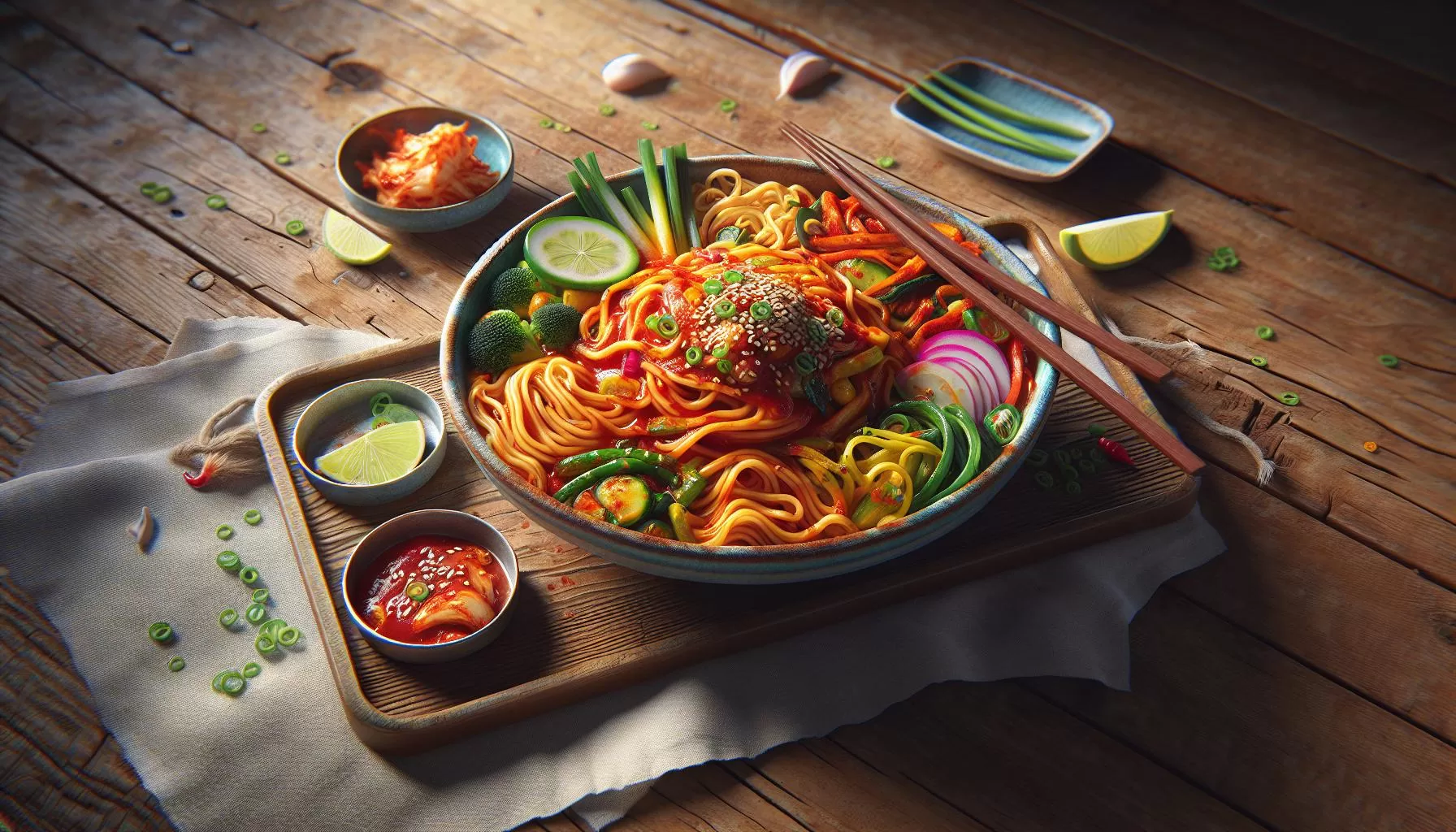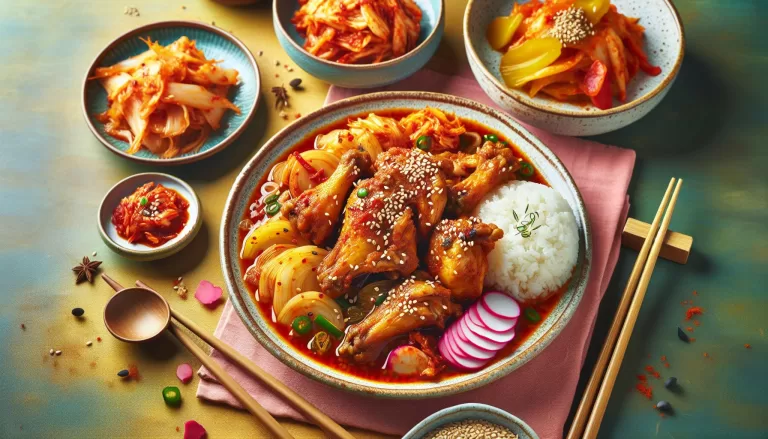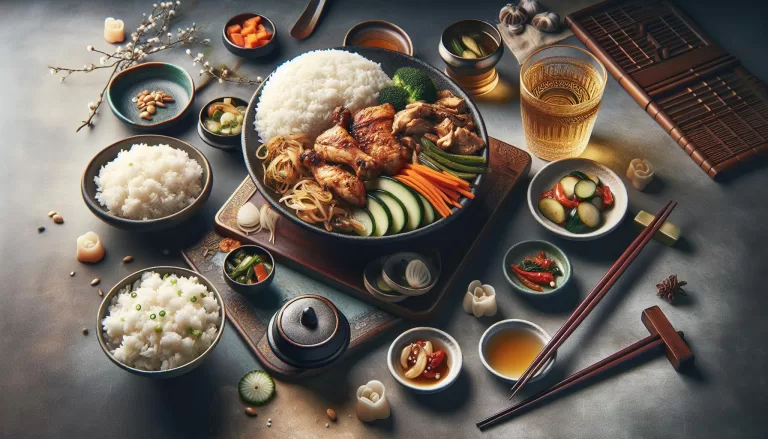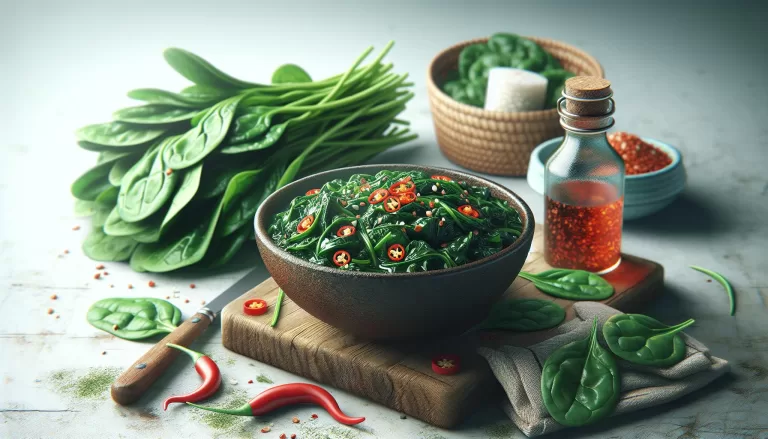Easy Homemade Bibim Guksu Korean Spicy Cold Noodles Recipe

What is Bibim Guksu?
Delving deeper into Korean cuisine, Bibim Guksu stands out. But what exactly is it? Allow us to take your culinary literacy a notch higher.
Bibim Guksu is a delightful, cold dish that’s soaked in flavor, history, and tradition. It’s essentially a spicy, cold noodle dish that uses thin wheat noodles, also known as “somyeon”. The word “Bibim” technically implies “mixed”, while “Guksu” means “noodles”. So, when you’re diving into a bowl of Bibim Guksu, you’re really getting a mouthful of mixed noodles.
This dish is well-known for its bold, spicy, and tangy flavors. It’s also famous for the refreshing sensation it leaves on the palate, which makes it a popular choice during the hot summer months in Korea. Bibim Guksu isn’t just about the taste, though. It comes with an added perk – it’s a breeze to prepare!
As for the sauce, mixtures vary, but yours is about to get an intimidating makeover. You’ll be guided to create a unique blend that includes red pepper paste, also known as Gochujang, and vinegar, amongst other ingredients. This sauce is what gives Bibim Guksu its signature tangy flavor.
Like any dish, Bibim Guksu can be customized to suit your taste buds. You can add in cucumber, boiled eggs, or even some slices of your preferred fruit. Yes, fruit! Some people might dismiss the idea, but once you’ve tried adding a few slices of pear or apple to your Bibim Guksu, you’ll understand the balance it brings to the dish.
Remember, it’s all about exploring flavors and embracing tradition. You’re not just preparing a meal; you’re creating a cultural experience right in your kitchen. Trust us – your taste buds are in for an exciting adventure.
Ingredients for Homemade Bibim Guksu

Now that we’ve dived into the exciting history, let’s delve into the nitty-gritty. Yes, it’s time to cook! But first, let’s gather our ingredients.
You’ll need:
- Noodles (soba or wheat noodles, 200g)
- Cucumber (1 medium)
- Boiled eggs (2)
- Asian pear (1 small, optional)
- Fresh red chili or bell pepper (1, optional for a sweeter crunch)
| Ingredient | Quantity |
|---|---|
| Soba or wheat noodles | 200g |
| Medium-sized cucumber | 1 |
| Boiled Eggs | 2 |
| Small Asian pear | 1 (Optional) |
| Red chili or bell pepper | 1 (Optional) |
Note: Bibim Guksu is incredibly adaptable. Replace or add ingredients as you fancy! Love something a little fruitier? Swap the Asian pear for an apple.
While shopping, pick up the essentials for our custom spicy dressing:
- Korean red pepper paste (Gochujang, 2 tablespoons)
- Soy sauce (2 tablespoons)
- Vinegar (2 tablespoons)
- Sugar (1 tablespoon)
- Korean red pepper powder (Gochugaru, 1 teaspoon)
- Sesame oil (1 tablespoon)
- Minced garlic (1 teaspoon)
- Sesame seeds (1 teaspoon)
| Ingredient | Quantity |
|---|---|
| Gochujang | 2 tbsp |
| Soy sauce | 2 tbsp |
| Vinegar | 2 tbsp |
| Sugar | 1 tbsp |
| Gochugaru | 1 tsp |
| Sesame oil | 1 tbsp |
| Minced garlic | 1 tsp |
| Sesame seeds | 1 tsp |
Again,** flexibility is key!** If you’re a sesame lover, add another sprinkle. If you’re a garlic somebody, heap it on!
Step-by-Step Preparation Guide

First, get that pot of water boiling. Once it’s bubbling, cook your noodles. While they’re cooking, you can start prepping the veggies. Slice your cucumber, red chilli or bell pepper, and Asian pear. Have ’em all ready to go. Finally, slice the boiled eggs for the perfect garnish.
Here’s a Quick Tip!
Not a fan of spice? Opt for bell pepper instead of red chilli. Want a crispier crunch? Slice the cucumber and pear a bit thicker. Remember, this is your Bibim Guksu.
Now’s the time to mix up that bold, spicy dressing. Combine your Korean red pepper paste, soy sauce, vinegar, sugar, red pepper powder, sesame oil, minced garlic, and sesame seeds. Mix it until the sugar’s fully dissolved. Remember, balance is key: your dressing should be spicy, sour, sweet, and savory. Want it a bit sweeter? Add more sugar. Craving more kick? Up that red pepper powder!
With your noodles cooked, veggies sliced, and dressing ready, you’re on the home stretch. Rinse your noodles under cold water for that perfect chewy texture. Next, toss ’em in a large bowl. Add the dressing, mix it well so every noodle’s covered, then top it with your sliced goodies.
Here’s Another Quick Tip!
Want to shake things up? Add a protein of your choice. Grilled shrimp, chicken or tofu – it’s your call. You’re only limited by your taste buds.
And there you have it: your very own Bibim Guksu. Now dig in and savor the explosion of flavors.
This recipe yields 4 servings. It’s perfect for a summer lunch – cold, spicy, and oh-so-refreshing. Dress it up with additional toppings, or enjoy it as is. Either way, it’s a real treat!
Enough talking. Get to the kitchen and start prepping. Don’t forget to share your cooking journey with us by tagging your pictures with #MyBibimGuksu on all your social platforms.
Tips for Perfecting the Dish

While making your homemade Bibim Guksu, you might wonder how to make it a standout dish. As you venture into this cooking journey, let’s explore some tips that’ll raise your game.
Choosing the right kind of noodles is crucial. You can opt for somyeon (thin wheat noodles) which is traditionally used for this dish. If that’s not handy, feel free to use your favorite type of thin noodles.
A real game-changer can be the inclusion of unique and unconventional ingredients. Consider adding herbs like thinly sliced perilla leaves for a fragrant and refreshing touch or lightly pickled radishes for that extra crunch. You’d be surprised at the depth these could add to your dish.
Keep a note of these alternative ingredients:
- Thinly sliced perilla leaves
- Lightly pickled radishes
For those interested in the nutritional value of your Bibim Guksu, it’s quite enriching. The different ingredients contribute to your daily necessary intake in their unique ways. To make it more health-forward, consider upping the vegetables or proteins. For a vegan twist, tofu or tempeh work great!
Remember, balance is the key factor in Korean cuisine. You’re in charge of how spicy, sweet, or tangy your Bibim Guksu will turn out. Don’t shy away from adjusting, such as adding more sugar for sweetness or vinegar for tanginess. It’s your homemade Bibim Guksu – make it to your taste!
One last tip: don’t rush through it. Savor the process, allow the flavors to infuse. And most importantly, have fun with it!
With these tips, insist on mastering the art of making Bibim Guksu. Experimenting is part of the recipe and might lead you to your best dish yet.
Serving and Enjoying Bibim Guksu

Now that you’ve mastered the art of making Bibim Guksu, it’s time to relish it to the fullest. There’s nothing quite like savoring a bowl of these spicy cold noodles, bursting with flavors and textures that scream comfort and satisfaction. Though it’s traditionally a summer dish, you can enjoy Bibim Guksu anytime because let’s face it – your cravings set their own rules!
Set the stage by arranging the ingredients aesthetically. Presentation matters, and it’s a quick tip to elevate your dish. A vibrant bowl of Bibim Guksu can brighten up any mealtime. Add a sprinkle of sesame seeds, a dash of sesame oil, and a garnish of fresh vegetables. Go ahead and toss in some pickled radishes or perilla leaves for that extra kick.
Sharing your culinary creation can be just as rewarding as the cooking process itself. So, invite your friends over to showcase your masterpiece and transform your cooking sessions into a full-fledged feast. Adorn your table with a variety of Korean appetizers like kimchi and barbecue for a more authentic experience.
Remember that Bibim Guksu, like most dishes, is flexible. It’s your dish, so feel free to tweak the existing recipe or add your personal touches. Love a particular vegetable? Toss it in! Prefer your noodles extra spicy? Up the gochujang! Embrace the liberty to make the dish exactly how you like it.
For those mindful of their daily nutrient intake, Bibim Guksu’s got your back. Its rich nutritional profile can be a game-changer! It’s packed with crucial nutrients like protein from the eggs and fiber from the veggies. Here’s a quick nutritional data breakdown:
| Nutrition | Per serving |
|---|---|
| Calories | 550 |
| Carbs | 100g |
| Protein | 17g |
| Fat | 10g |
| Vitamin A | 200% |
| Vitamin C | 150% |
Conclusion
You’ve journeyed through the art of making homemade Bibim Guksu and now it’s time to savor your creation. Remember, the beauty of this dish lies in its versatility. Whether you’re serving it up for friends or enjoying it solo, it’s a culinary delight that’s as satisfying as it is nutritious. Don’t shy away from adding your own twist – the dish is as unique as you are. With its high protein, fiber, and essential vitamins, Bibim Guksu isn’t just a flavorful feast, it’s a healthful choice too. So go ahead, roll up your sleeves and dive into the world of Korean cuisine. Your taste buds will thank you.





